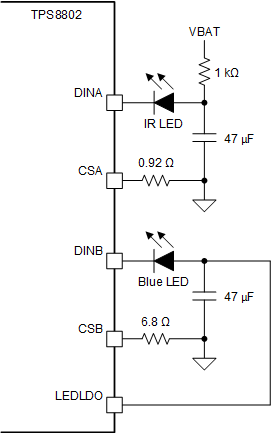SLVAET3 October 2021 TPS8802
- Trademarks
- 1Introduction
- 2System Architecture
- 3Current Consumption
- 4System Power Calculation and Measurements
- 5Summary
- 6References
2.4.1 LED Connected to VBAT
A low current infrared LED can be powered directly from the battery through a current-limiting resistor and large capacitor. This is the most efficient way to power the LED. Ensure the minimum battery voltage is greater than VLED(MIN).
 Figure 2-5 IR LED Connected to VBAT Through a Current-Limiting Resistor
Figure 2-5 IR LED Connected to VBAT Through a Current-Limiting Resistor